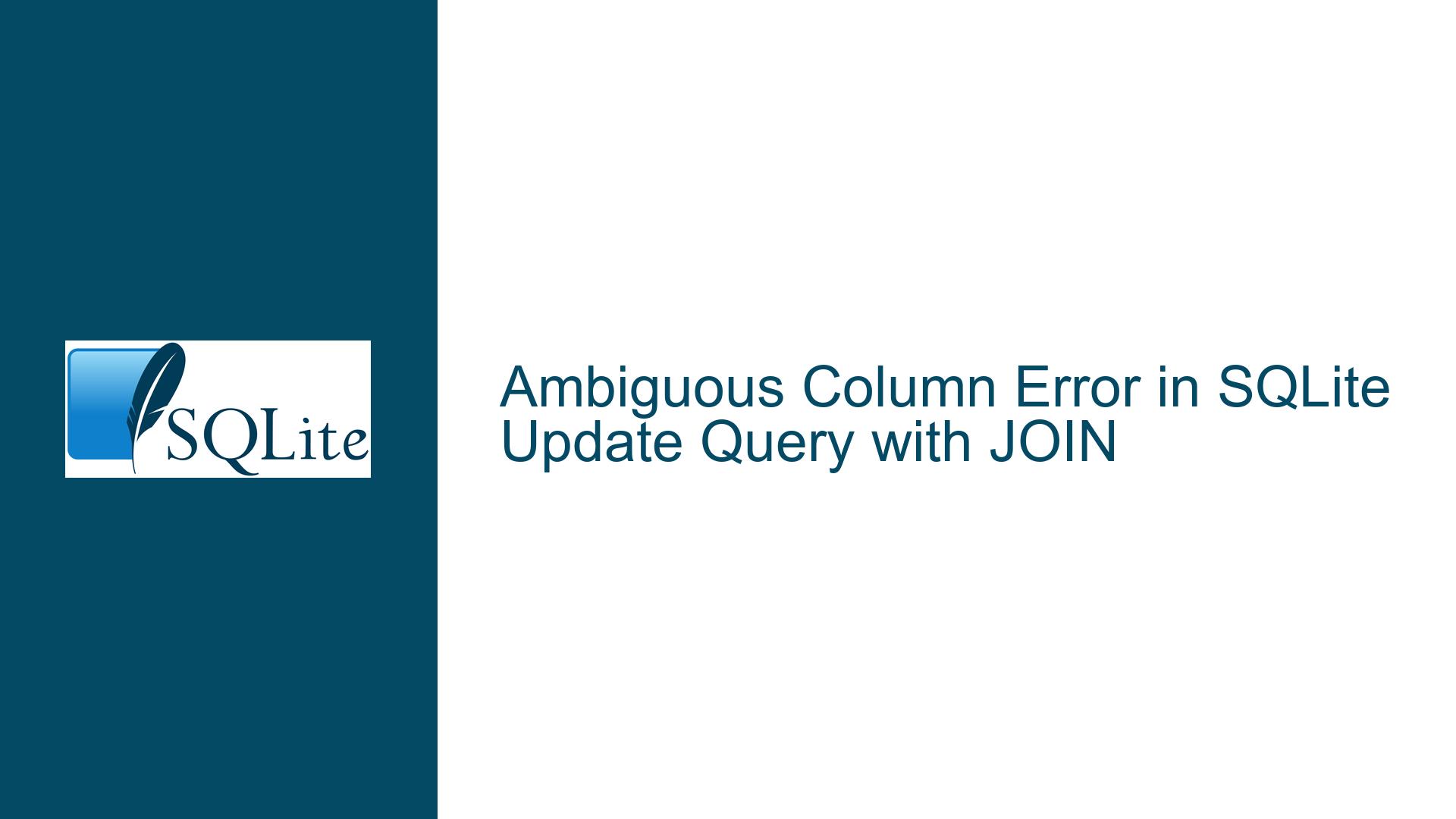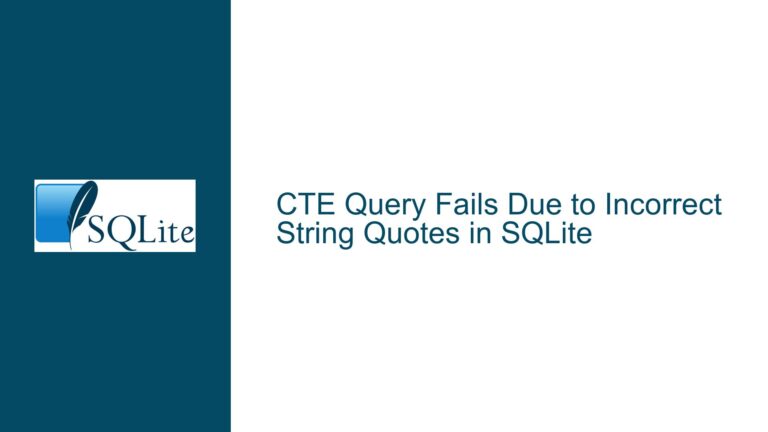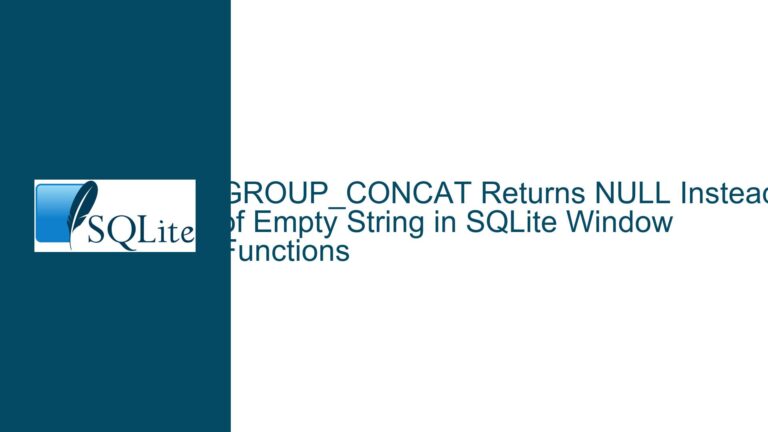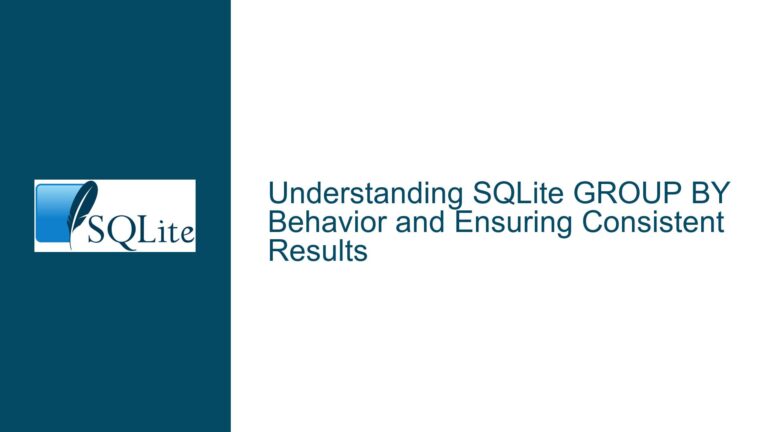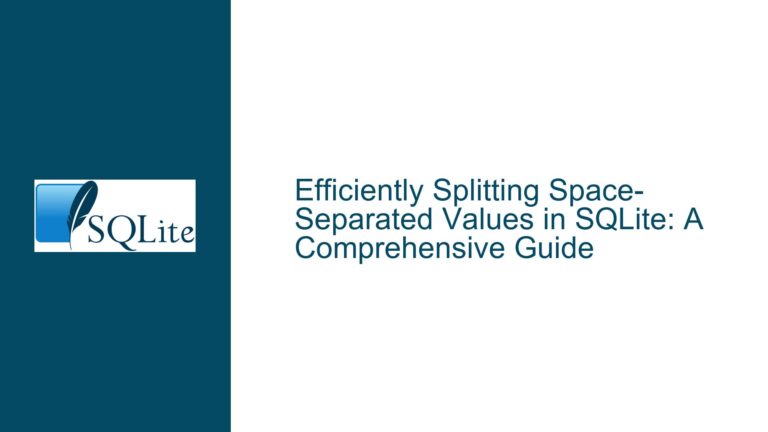Ambiguous Column Error in SQLite Update Query with JOIN
Ambiguous Column Error in SQLite Update Query with JOIN
When working with SQLite, one common issue that developers encounter is the "ambiguous column name" error, particularly when performing an UPDATE query that involves a JOIN operation. This error typically arises when the SQLite parser cannot determine which instance of a column name to reference, especially when the same table is referenced multiple times in the query. In the context of the provided discussion, the error occurred during an attempt to update the SelectOrder column in a table named Test based on a JOIN operation with a Common Table Expression (CTE).
The error message "ambiguous column name: Test.Included" indicates that SQLite encountered a situation where it could not resolve which instance of the Test table the Included column belonged to. This ambiguity arises because the Test table was referenced twice in the query: once in the UPDATE statement and again in the FROM clause of the JOIN operation. SQLite, unlike some other database systems like SQL Server, does not allow the same table to be referenced multiple times in this manner without explicit disambiguation.
The core of the issue lies in the way SQLite handles the UPDATE statement when combined with a JOIN. In SQLite, the UPDATE statement can include a FROM clause, which allows the UPDATE to reference other tables or subqueries. However, when the target table of the UPDATE is also included in the FROM clause, SQLite cannot distinguish between the instances of the table, leading to the ambiguous column error.
Interrupted Write Operations Leading to Index Corruption
The ambiguous column error in SQLite is not directly related to interrupted write operations or index corruption, but it is worth noting that such issues can arise in more complex scenarios involving multiple table references and joins. In the context of the provided discussion, the error was purely syntactic, but in other cases, similar errors could be indicative of deeper issues such as schema corruption or improper indexing.
In SQLite, the UPDATE statement with a JOIN can be particularly tricky because the database engine must correctly resolve the relationships between the tables involved in the JOIN and the target table of the UPDATE. If the schema is not properly designed or if there are issues with the indexes, the database engine might struggle to resolve these relationships, leading to errors or unexpected behavior.
For example, if the Test table had a corrupted index on the ID column, the JOIN operation might fail to correctly match rows between the Test table and the CTE, leading to incorrect updates or even data corruption. While this was not the case in the provided discussion, it is important to be aware of such possibilities when working with complex UPDATE queries in SQLite.
Implementing Correct JOIN Syntax in SQLite UPDATE Queries
To resolve the ambiguous column error in SQLite, it is essential to correctly structure the UPDATE query to avoid multiple references to the same table without proper disambiguation. In the provided discussion, the solution involved removing the redundant reference to the Test table in the FROM clause of the JOIN operation. This ensures that SQLite can correctly resolve the column references without ambiguity.
The corrected query is as follows:
WITH WindowOrder AS (
SELECT ID, row_number() OVER (ORDER BY ID DESC) AS RowNumber
FROM Test
WHERE Included
)
UPDATE Test
SET SelectOrder = WindowOrder.RowNumber
FROM WindowOrder
WHERE Test.ID = WindowOrder.ID AND Test.Included;
In this corrected query, the Test table is referenced only once in the UPDATE statement, and the FROM clause only includes the WindowOrder CTE. This eliminates the ambiguity that caused the original error. The WHERE clause then correctly filters the rows to be updated based on the Included column in the Test table.
It is also important to note that SQLite’s handling of UPDATE statements with JOIN operations differs from other database systems like SQL Server. In SQL Server, it is common to include the target table in the FROM clause of the JOIN, but this is not necessary in SQLite and can lead to errors. Developers familiar with other database systems should be aware of these differences when writing SQLite queries.
To further illustrate the correct usage of UPDATE with JOIN in SQLite, consider the following example:
-- Create a temporary table
CREATE TEMP TABLE Orders (
OrderID INTEGER PRIMARY KEY,
CustomerID INTEGER,
OrderDate DATE,
TotalAmount REAL
);
-- Insert sample data
INSERT INTO Orders VALUES (1, 101, '2023-01-01', 100.00);
INSERT INTO Orders VALUES (2, 102, '2023-01-02', 200.00);
INSERT INTO Orders VALUES (3, 101, '2023-01-03', 150.00);
-- Create a temporary table for customers
CREATE TEMP TABLE Customers (
CustomerID INTEGER PRIMARY KEY,
CustomerName TEXT,
TotalSpent REAL
);
-- Insert sample data
INSERT INTO Customers VALUES (101, 'Alice', 0.00);
INSERT INTO Customers VALUES (102, 'Bob', 0.00);
-- Update the TotalSpent column in the Customers table
WITH CustomerTotals AS (
SELECT CustomerID, SUM(TotalAmount) AS TotalSpent
FROM Orders
GROUP BY CustomerID
)
UPDATE Customers
SET TotalSpent = CustomerTotals.TotalSpent
FROM CustomerTotals
WHERE Customers.CustomerID = CustomerTotals.CustomerID;
In this example, the UPDATE statement correctly references the Customers table only once, and the FROM clause includes the CustomerTotals CTE. This ensures that there is no ambiguity in the column references, and the query executes without errors.
In conclusion, the ambiguous column error in SQLite UPDATE queries with JOIN operations can be resolved by carefully structuring the query to avoid redundant table references. Developers should be aware of the differences between SQLite and other database systems when writing such queries and should always test their queries thoroughly to ensure correct execution. By following these best practices, developers can avoid common pitfalls and ensure that their SQLite queries are both efficient and error-free.
